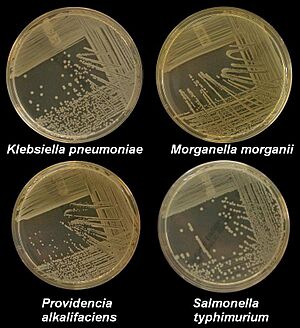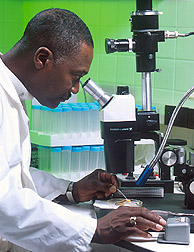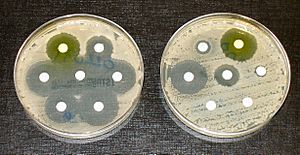Medical microbiology facts for kids


Medical microbiology is a science that studies tiny living things called microbes. These include bacteria, viruses, fungi, and parasites. This field looks at how these microbes can make people sick and how they cause diseases.
Microbes are very important to medicine. Because of this, they are studied a lot in microbiology. Medical microbiology also explores how infectious diseases start and spread. This includes how they affect one person and how they spread through many people (epidemiology). It is closely connected to studying how diseases harm the body (pathology) and how the body fights off sickness (immunology).
This branch of medicine and microbiology includes five main areas:
- Bacteriology: The study of bacteria.
- Virology: The study of viruses.
- Parasitology: The study of parasites.
- Immunology: The study of the body's defense system.
- Mycology: The study of fungi.
Contents
How Medical Microbiology Started
In 1546, a scientist named Girolamo Fracastoro suggested an idea. He thought that epidemic diseases, which spread quickly, were caused by tiny "seeds." He believed these seeds could pass from person to person. This could happen through direct touch, indirect contact, or even from a distance.
Two very important scientists, Louis Pasteur and Robert Koch, are seen as the founders of medical microbiology.
Louis Pasteur's Discoveries
Louis Pasteur is famous for his experiments. He proved that the idea of spontaneous generation was wrong. This old idea said that living things could just appear from non-living matter. Pasteur showed that life comes from existing life. He also found ways to keep food safe, like pasteurization for milk. He developed the first vaccines against serious diseases. These included vaccines for anthrax, fowl cholera, and rabies.
Robert Koch's Contributions
Robert Koch helped create the germ theory of disease. This theory states that specific diseases are caused by specific microbes. He developed a set of rules called Koch's postulates. These rules help scientists figure out if a certain microbe causes a certain disease. Koch was also one of the first to grow bacteria in a pure culture. This means growing only one type of bacteria without others. He used this method to describe several bacteria. One important discovery was Mycobacterium tuberculosis, the microbe that causes tuberculosis.
What Medical Microbiologists Study
Medical microbiology has several important areas of study. Each area focuses on a different part of how microbes work and how they affect health.
- Microbial physiology: This area looks at how microbes grow, how they get energy (metabolism), and what their cells are made of.
- Microbial genetics: This is the study of how genes are organized in microbes. It also looks at how these genes control what the microbe does.
- Parasitology: This field investigates parasites. Scientists often check samples like feces, blood, urine, and sputum to find them.
- Virology: This area focuses on finding viruses in samples. These samples can include blood, urine, and cerebrospinal fluid (fluid around the brain and spinal cord).
- Immunology/Serology: This field uses how antigens and antibodys interact to diagnose diseases. It also helps check if organs are a good match for organ transplants.
The Role of a Medical Microbiologist
A medical microbiologist is a doctor or scientist who specializes in medical microbiology. They play a key role in fighting infectious diseases.
Helping Patients and Public Health
Medical microbiologists give advice to doctors about patients with infections. They help figure out what is causing the illness. They also suggest the best ways to treat it. They also create and manage programs to control infections. These programs help prevent diseases from spreading in hospitals and in the wider community. They are very important in public health and understanding how diseases spread (epidemiology).
Working in the Lab
A medical microbiologist also manages a clinical microbiology laboratory. This lab receives many different types of samples from patients. These can include swabs, feces, urine, blood, sputum, and even infected tissues. In the lab, scientists often grow cultures from these samples. They look for microbes that might be causing the illness. If they find a harmful microbe, they identify it using special tests. They also test if the microbe is sensitive or resistant to different medicines. This helps doctors choose the right medicine for the patient. The lab then reports which microbe was found and which medicines will work best.
Teaching and Research
Medical microbiologists also teach students at different levels. They also do research to learn more about microbes and diseases. Their research has led to the creation of many important vaccines. These vaccines have helped fight deadly diseases. For example, diseases like smallpox and polio have been almost wiped out. Diseases like tuberculosis have become much easier to treat.
Scientists are also exploring new ways microbes can help us. Some believe that eating probiotics (good bacteria) and prebiotics (food for good bacteria) can improve health. There are also ideas that microbes could help treat cancer. Some harmless bacteria, like certain types of clostridia, can grow inside tumors. They might be able to deliver medicines directly to the cancer cells.
Images for kids
See also
 In Spanish: Microbiología y parasitología para niños
In Spanish: Microbiología y parasitología para niños




